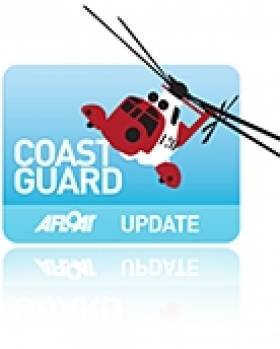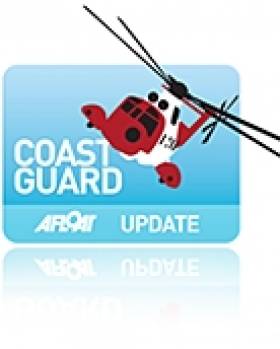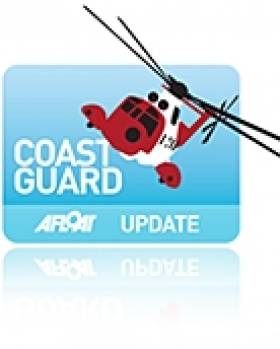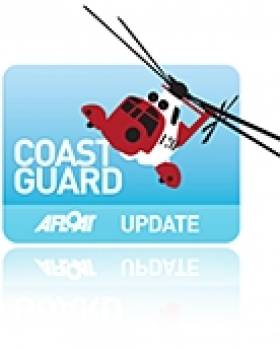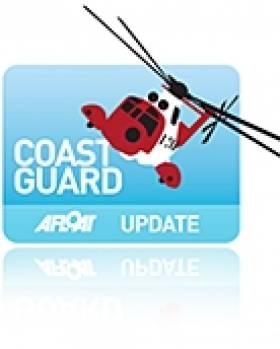Displaying items by tag: Coastguard
Couple Rescued After Failed Attempt to Board Yacht
#RESCUE– A couple in their sixties were rescued from the water in the River Teifi, Cardigan today after their attempt to climb aboard their yacht ended with them both in the water.
Milford Haven Coastguard received a call from a member of the public at just before 10.30 am this morning. A member of the public reported that a fully-dressed person was in the water hanging on to the side of a boat. Whilst the call was being made another member of the public rowed out to the casualties.
It later transpired that there were two people in the water. The first fell in when the tender overturned as she tried to board the yacht. The second jumped off the yacht to help. Neither were wearing life jackets and the weather was far from ideal, with strong gusty winds and a very high tide.
Cardigan RNLI Lifeboat was sent to the scene, with coastguard rescue officers from Gwbert, who met the casualties and looked after them until an ambulance arrived.
Mike Day, from Milford Haven Coastguard, said :
"Both these people were very lucky to have been seen in the water so quickly. Our thanks go to the member of the public who went to their aid and pulled both from the water. This also shows the importance of wearing a lifejacket even for the shortest trips"
Search for Missing Seafarers Finishes for the Night
Four lifeboats, four helicopters, three coastguard rescue teams, two merchant vessels and a fixed wing aircraft have searched an area of approximately 300 square miles today. However, sadly the only sign of the missing seafarers has been their two liferafts, a lifebuoy from the vessel and a survival suit.
In the early hours of this morning two seafarers were airlifted from the sea and a third person was found, but sadly he was deceased.
The 81-metre cargo carrier, 'Swanland' broadcast a mayday message at 2.00 am this morning. The ship reported that their hull was cracking, due to bad weather and that they thought that it may be taking water. Holyhead Coastguard broadcast a mayday relay and several vessels responded. Two of these vessels were able to go to the assistance of the Swanland and its eight crew. When the two vessels arrived at the scene, they found two liferafts and some floating debris. They were able to provide shelter from the gale force winds, whilst awaiting the arrival of rescue resources. Meanwhile Holyhead Coastguard had scrambled two rescue helicopters and requested the launch of two lifeboats.
When the helicopters arrived on scene they found two crew members in the water clinging to the liferafts. These two were airlifted from the sea into the RAF helicopter and taken to RAF Valley. A short while later a third person, who was deceased was found. The search is continued throughout the day for the other five with additional rescue resources being added as the day progressed
Holyhead Coastguard Watch Manager Mark Craddock says:
"Sadly, despite a 14-search involving land, sea and air assets, we have not been able to find any sign of the missing men. As darkness draws in we are releasing the rescue crews."
Search Continues for Six Seafarers Missing on the Irish Sea
#RESCUE–Holyhead Coastguard is currently coordinating the search for six merchant seafarers who are missing in gale force weather 10 miles west of the Lleyn peninsula, Gwynedd.
The 81-metre cargo carrier, 'Swanland' broadcast a mayday message at 2.00 am this morning. The ship reported that their hull was cracking, due to bad weather and that they thought that it may be taking water. Holyhead Coastguard broadcast a mayday relay and several vessels responded. Two of these vessels were able to go to the assistance of the Swanland and its eight crew. When the two vessels arrived at the scene, they found two liferafts and some floating debris. They were able to provide shelter from the gale force winds, whilst awaiting the arrival of rescue resources. Meanwhile Holyhead Coastguard had scrambled the two rescue helicopters from RAF Valley and Dublin Coastguard and requested the launch of the Pwllheli and Porth Dinllaen RNLI all weather lifeboats.
When the helicopters arrived on scene they found two crew members in the water clinging to the liferafts. These two were airlifted from the sea into the RAF helicopter and taken to RAF Valley. The search is continuing for the other six. The original two helicopters have now been replaced with a helicopter from RAF Chivenor and an Irish Coastguard helicopter.
Holyhead Coastguard Watch Manager Jim Green says:
"We are very concerned for the safety of the other six crew members. We know that at least some of them are wearing immersion suits and have strobe lighting with them, however sea conditions are challenging at best.
The cargo vessel had 3000 tonnes of limestone onboard. It appears that it may have sunk."
French Fishermen Rescued
At 9.45am Belfast Coastguard received the report of a man with abdominal pains from the fishing vessel 'Saint Gothard' south east of Strangford Lough. The skipper had spoken to a doctor who had advised that the 50 year old man should be taken to hospital as soon as possible.
It quickly became apparent that the crew did not speak English and so the French Coastguard from Maritime Rescue Coordination Centre in Gris Nez agreed to translate. Using three-way communications, which included satellite telephones and coastguard equipment, Belfast Coastguard, the crew of the Irish helicopter and the Coastguard at Gris Nez managed to communicate with the vessel, explaining how to set-up a high-line transfer and the best direction and speed of the vessel for the winchman. The sick crew man was successfully airlifted, by the Irish Coastguard helicopter in Gale force 8 winds and taken to hospital in Newry, Northern Ireland.
Belfast Coastguard, Watch Manager Steve Carson said:
"I'd like to thank our colleagues in Ireland and France for their help with this rescue, which ensured that a sick fisherman now has the medical attention he needs. "
New Coastguard Command Vehicle For West Coast
#COASTGUARD - The Irish Coast Guard has received the keys to a new Mobile Incident Command Vehicle to be based in Sligo.
Minister of State Michael Ring made the presentation to Irish Coast Guard director Chris Reynolds ahead of the body’s annual conference in Westport last weekend, Mayo Today reports.
The new vehicle will be used for on-scene management of major marine emergencies aling the west and north-west coasts. It is fitted with all modern communications equipment and will be on call 24/7.
Reynolds commented: “Over the past few months we have launched five new coastguard boats and early next we will see the delivery of seven new vessels.
“This month we will take delivery of 11 new vehicles including vans and 4x4s and in the coming weeks, we take delivery of our new S92 helicopters.”
It's Official - Bangor Coastguard Will Stay Open
#COASTGUARD - The UK's shipping minister has confirmed that Northern Ireland will retain its only coastguard station, the News Letter reports.
Mike Penning made the survival of Bregenz House official at the House of Commons yesterday, marking the end of what has been a successful campaign by the station's supporters.
As previously reported on Afloat.ie, the control centre at Bangor was given a last-minute reprieve by the minister in July under revised proposals to streamline the UK's coastguard network.
Bregenz House will be one of eight stations set to remain following the cutbacks, and one of just three across the whole UK that will have 24-hour service.
However, concerns are still being expressed about the wider area that the Bangor station will now have to cover, with the coastguard workers' union calling for assurances that the "same level of service" will be preserved.
Unconscious Man Rescued from Incoming Tide
He had been found lying in a muddy ditch in 10 inches of water by a man and his dog. Jumping in to hold his head above the rising water his rescuer managed to attract the attention of some builders working nearby. They called the ambulance, who alerted Holyhead Coastguard.
The RAF Rescue helicopter from Valley was sent to the scene with Criccieth Coastguard Rescue Team and paramedics. The man was rescued from the ditch and taken to hospital by helicopter.
Holyhead Coastguard Watch Manager Barry Priddis said:
"This gentleman was really lucky to be found as the tide was coming in and he would soon have been beneath the water. If I was him I'd buy a lottery ticket tonight."
Man Dies After Car Plunges Into Howth Harbour
Members of the public alerted the Irish Coast Guard after seeing the car driving onto the west pier.
Despite a rapid response from the coastguard and Howth RNLI lifeboat, a search of the surface showed no sign of the car.
Garda divers later made the grim discovery and recovered the man's body.
Fishing Vessel Runs Aground at Ardglass Harbour
The 15 metre vessel was returning from a fishing trip when it hit the rocks. With the vessel listing at 30 degrees they broadcast a mayday alert on Channel 16 before the four crew took to the life raft. They were rescued from there by another fishing vessel 'The Three Coins'.
All four crew were brought ashore at Ardglass Harbour safe and well where the South Down Coastguard Rescue Team met them. The damage to the 'Moyuna' is now being assessed.
Belfast Coastguard Watch Manager Alan Pritchard said:
"The crew did exactly the right thing in calling for assistance and taking to the life raft to wait for help to reach them.
"The MAIB have been informed and they will be investigating the circumstances that led to tonight's grounding. MCA's surveyors are also aware."
Single Transport Safety Body Could Include Coastguard
The Maritime Safety Directorate (MSD) is comprised of two main sections; the Marine Survey Office (MSO) which includes the Marine Radio Affairs Unit (MRAU) and the Maritime Safety Policy Division.
Minister for Transport, Tourism and Sport Leo Varadkar has confirmed proposals to reduce number of Departmental agencies today. It is part of Government plans to drive efficiencies in the public sector.
Further legislation will be published to combine the Sports Council with the National Sports Campus Development Agency. The new body will not be decentralised, and will instead be a key tenant at the Sports Campus at Abbotstown.
A separate critical review will be conducted of the roles of Dublin Tourism and the tourism function of Shannon Development, with a recommendation and decisions due next year.
Minister Varadkar said: 'The Government is determined to tackle waste and end duplication in public spending. This is essential in order to boost the economy and create jobs, keep taxes low, and protect public services'.
"I have already abolished the Dundalk Port Company board, while Coaching Ireland has been subsumed into the Irish Sports Council.
"We are working hand in hand with the public service to create a State sector which is best equipped to achieve these crucial goals. This process of rationalisation will allow us to cut costs, keep taxes low, and maintain competitiveness over the next five years."



























